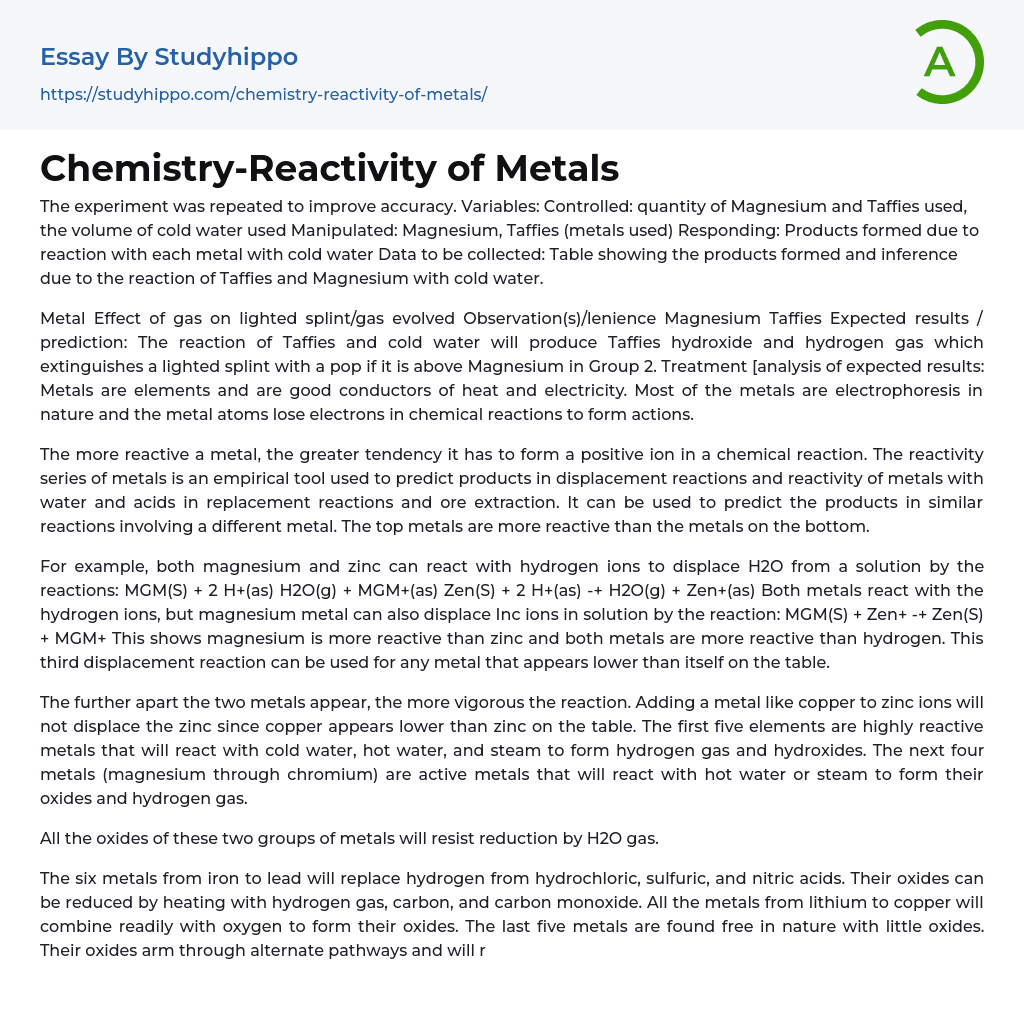The experiment was repeated in order to increase precision.
Variables:
Controlled: quantity of Magnesium and Taffies used, the volume of cold water used
Manipulated: Magnesium, Taffies (metals used)
Responding: Products formed due to reaction with each metal with cold water
Data to be collected: Table showing the products formed and inference due to the reaction of Taffies and Magnesium with cold water.
Metal Effect of gas on lighted splint/gas evolved Observation(s)/lenience
Magnesium Taffies Expected results / prediction: The reaction of Taffies and cold water will produce Taffies hydroxide and hydrogen gas which extinguishes a lighted splint with a pop if it is above Magnesium in Group 2.
Treatment [analysis of expected results: Metals are elements and are good conductors of heat and electricity. Most of the metals are electrophoresis in nature and the me
tal atoms lose electrons in chemical reactions to form actions. The more reactive a metal, the greater tendency it has to form a positive ion in a chemical reaction. The reactivity series of metals is an empirical tool used to predict products in displacement reactions and reactivity of metals with water and acids in replacement reactions and ore extraction.
The text discusses the use of predicting products in similar reactions involving different metals. The relative reactivity of metals is determined by their position on a table. For example, both magnesium and zinc can react with hydrogen ions to displace water from a solution. The reactions are as follows:
Mg(s) + 2 H+(aq) -> H2(g) + Mg2+(aq)
Zn(s) + 2 H+(aq) -> H2(g) + Zn2+(aq)
Both metals react with hydrogen ions, but magnesium can also displace zinc ions in solution:
Mg(s) + Zn2+(aq) -> Zn(s) +
Mg2+(aq)
This demonstrates that magnesium is more reactive than zinc, and both metals are more reactive than hydrogen. This third displacement reaction can be applied to any metal that appears lower than itself on the table. The larger the gap between two metals on the table, the stronger the reaction. For instance, placing copper in zinc ions will not displace the zinc since copper appears lower than zinc on the table.
The first group of five elements are extremely reactive metals that undergo reactions with cold water, hot water, and steam, resulting in the production of hydrogen gas and hydroxides. Following this, the four metals from magnesium through chromium are considered active metals as they react with hot water or steam, forming their respective oxides and hydrogen gas. All oxides belonging to these two groups of metals exhibit resistance towards reduction by H2O gas. Moving on, the six metals ranging from iron to lead are capable of displacing hydrogen from hydrochloric, sulfuric, and nitric acids. Furthermore, their oxides can be reduced through heating with hydrogen gas, carbon, and carbon monoxide.
All metals from lithium to copper easily react with oxygen to form oxides. The last five metals occur naturally in their pure form with minimal oxide content. These metal oxides follow different pathways and easily break down upon exposure to heat. The group 2 elements in the periodic table are referred to as alkaline earth metals.
The alkaline earth metals, beryllium (Be), magnesium (MGM), calcium (Ca), strontium (Sir), barium (Baa), and radium (Ra), make up the s-block elements in group 2. This series is effective for reactions occurring at room temperature and in aqueous solutions. However, there are limitations.
Other residues in the beaker from previous experiments may react with the water, producing a gas that could ignite with a lighted splint. It is important to conduct experiments quickly to prevent the cold water in the beaker from heating up too much.
B. It is important to light the splint either before adding the metal to the beaker with cold water or at the same time, in order to test for any gas produced before it escapes from the beaker's atmosphere. Assumptions: If there is a reaction, the amount of water used is enough to fully react with the two spatula loads of each metal.
The gas produced in both experiments was a result of the reaction between the water and metal used.
- Organic Chemistry essays
- Acid essays
- Calcium essays
- Chemical Bond essays
- Chemical Reaction essays
- Chromatography essays
- Ethanol essays
- Hydrogen essays
- Periodic Table essays
- Titration essays
- Chemical reactions essays
- Osmosis essays
- Carbohydrate essays
- Carbon essays
- Ph essays
- Diffusion essays
- Copper essays
- Salt essays
- Concentration essays
- Sodium essays
- Distillation essays
- Amylase essays
- Magnesium essays
- Acid Rain essays
- Steel essays
- Agriculture essays
- Albert einstein essays
- Animals essays
- Archaeology essays
- Bear essays
- Biology essays
- Birds essays
- Butterfly essays
- Cat essays
- Charles Darwin essays
- Chemistry essays
- Dinosaur essays
- Discovery essays
- Dolphin essays
- Elephant essays
- Eli Whitney essays
- Environmental Science essays
- Evolution essays
- Fish essays
- Genetics essays
- Horse essays
- Human Evolution essays
- Isaac Newton essays
- Journal essays
- Linguistics essays




